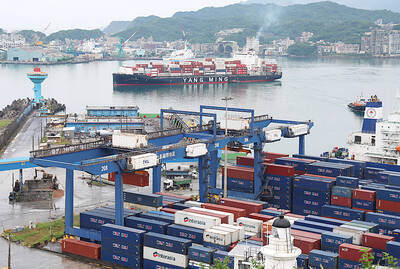For chip buyers ranging from computer gamers to automakers, there is no near-term fix on the way for shortages that have caused higher prices and production delays, semiconductor executives said.
Nvidia Corp, which makes chips that are the basis of graphics cards selling for thousands of US dollars more than their retail prices, sees some improvement in supply in the second half of the year, chief financial officer Colette Kress said on Wednesday at the JP Morgan Tech/Auto Forum.
Her comments led a string of presentations by other executives that similarly repeated their chip companies’ outlook for when supply and demand might reach some sort of balance. The bottom line is that most companies do not see any improvement before the middle of this year and many are saying not even then.

Photo: Bloomberg
Like other chipmakers that outsource their production, Nvidia has struggled to secure enough supply to meet demand. That bottleneck has hurt even the largest companies. Apple Inc, for example, has said it missed out on more than US$6 billion of revenue last quarter, because it could not get enough components.
For one of the companies that provides contract manufacturing, GlobalFoundries Inc, the surge in uses for chips coupled with the time it takes to increase capacity, means that this year would offer scant relief.
“It’s hard to imagine over the next two years a point where we don’t speak about supply issues,” GlobalFoundries CEO Tom Caulfield said during his appearance at the forum. “I don’t see any relief in 2022.”
Automakers have missed out on billions of US dollars in revenue, because they could not get the electronic components that are central to their products. Some of the industry’s chip suppliers stuck to a cautious outlook about when they would be able to fill orders more quickly.
ON Semiconductor Corp CEO Hassane El-Khoury told the online audience that demand would continue to outpace supply for the rest of this year. His company’s chips control the distribution of power in vehicles, particularly those running on electricity.
Analog Devices Inc, another major automotive chip supplier, was slightly more optimistic.
Growing orders would devour all of its supply until the fiscal third quarter, which ends in July, chief financial officer Prashanth Mahendra-Rajah said, adding that the company expects to significantly increase its supply output in the fourth quarter.
All the executives said that the demand is a fair reflection of the needs of their customers.
There is no sign of the kind of hoarding that might cause an inventory glut and later collapse in demand, they said.

CHIP RACE: Three years of overbroad export controls drove foreign competitors to pursue their own AI chips, and ‘cost US taxpayers billions of dollars,’ Nvidia said China has figured out the US strategy for allowing it to buy Nvidia Corp’s H200s and is rejecting the artificial intelligence (AI) chip in favor of domestically developed semiconductors, White House AI adviser David Sacks said, citing news reports. US President Donald Trump on Monday said that he would allow shipments of Nvidia’s H200 chips to China, part of an administration effort backed by Sacks to challenge Chinese tech champions such as Huawei Technologies Co (華為) by bringing US competition to their home market. On Friday, Sacks signaled that he was uncertain about whether that approach would work. “They’re rejecting our chips,” Sacks

Taiwan’s exports soared 56 percent year-on-year to an all-time high of US$64.05 billion last month, propelled by surging global demand for artificial intelligence (AI), high-performance computing and cloud service infrastructure, the Ministry of Finance said yesterday. Department of Statistics Director-General Beatrice Tsai (蔡美娜) called the figure an unexpected upside surprise, citing a wave of technology orders from overseas customers alongside the usual year-end shopping season for technology products. Growth is likely to remain strong this month, she said, projecting a 40 percent to 45 percent expansion on an annual basis. The outperformance could prompt the Directorate-General of Budget, Accounting and

NATIONAL SECURITY: Intel’s testing of ACM tools despite US government control ‘highlights egregious gaps in US technology protection policies,’ a former official said Chipmaker Intel Corp has tested chipmaking tools this year from a toolmaker with deep roots in China and two overseas units that were targeted by US sanctions, according to two sources with direct knowledge of the matter. Intel, which fended off calls for its CEO’s resignation from US President Donald Trump in August over his alleged ties to China, got the tools from ACM Research Inc, a Fremont, California-based producer of chipmaking equipment. Two of ACM’s units, based in Shanghai and South Korea, were among a number of firms barred last year from receiving US technology over claims they have

BARRIERS: Gudeng’s chairman said it was unlikely that the US could replicate Taiwan’s science parks in Arizona, given its strict immigration policies and cultural differences Gudeng Precision Industrial Co (家登), which supplies wafer pods to the world’s major semiconductor firms, yesterday said it is in no rush to set up production in the US due to high costs. The company supplies its customers through a warehouse in Arizona jointly operated by TSS Holdings Ltd (德鑫控股), a joint holding of Gudeng and 17 Taiwanese firms in the semiconductor supply chain, including specialty plastic compounds producer Nytex Composites Co (耐特) and automated material handling system supplier Symtek Automation Asia Co (迅得). While the company has long been exploring the feasibility of setting up production in the US to address